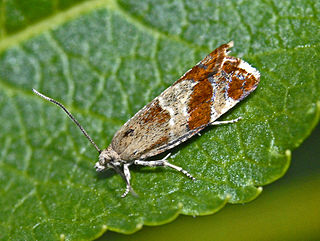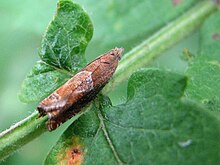
Syndemis musculana is a moth of the family Tortricidae. It is found in Europe, China, the Korean Peninsula, Japan, Russia (Amur) and North America.

Epinotia ramella is a moth of the family Tortricidae. It is found in Europe, China, Japan, Russia and Kazakhstan.

Epinotia solandriana is a moth of the family Tortricidae. It is found in Europe, China, Korea, Japan, and Russia.

The Zeiraphera griseana, the larch tortrix, is a moth of the family Tortricidae.

Epinotia is a very large genus of tortrix moths. It belongs to the tribe Eucosmini of subfamily Olethreutinae.

Epinotia cruciana, the willow tortrix, is a moth of the family Tortricidae.
Epinotia rubiginosana is a moth of the family Tortricidae. It is found from Europe to eastern Russia, China, Korea and Japan.

Epinotia signatana is a moth of the family Tortricidae. It is found from England and Scandinavia to the Mediterranean Sea, to eastern Russia, China, Korea, Burma and Japan.

Rhopobota naevana, the holly tortrix moth, holly leaf tier or blackheaded fireworm, is a moth of the family Tortricidae. It is found from Europe to eastern Russia, China, Taiwan, Mongolia, Korea and Japan. It is also present in India, Sri Lanka and North America.

Rhyacionia pinicolana is a moth of the family Tortricidae. It is found from northern and central Europe to eastern Russia, China, Japan and Korea.
Zeiraphera rufimitrana, the red-headed fir tortricid, is a moth of the family Tortricidae. It is found from central Europe to eastern Russia, Mongolia, the Korean Peninsula, China and Japan. It was first recorded from the Netherlands by Kuchlein and Naves in 1999.

Epinotia brunnichana is a moth of the family Tortricidae. It is found in most western, central and northern Europe, the Near East and further east to the eastern Palearctic realm, where it has been recorded from Russia, Kazakhstan, China, and Japan.

Epinotia tetraquetrana, the square-barred bell, is a moth of the family Tortricidae. It is found from most of Europe east to the Near East and the eastern part of the Palearctic realm.

Tosirips perpulchrana is a moth of the family Tortricidae. It is found in the Russian Far East, north-eastern China, Korea, Japan and Taiwan.

Epinotia thapsiana is a moth of the family Tortricidae. It was described by Philipp Christoph Zeller in 1847. It is found in the Netherlands, France, Spain, Portugal, Switzerland, Austria, Italy, Slovakia, Hungary, Slovenia, Serbia, North Macedonia, Albania, Greece, Russia, Asia Minor, Iran, Kyrgyzstan, Tajikistan, Turkmenistan, China and Korea.

Choristoneura lafauryana, the strawberry leafroller, is a species of moth of the family Tortricidae. It is found in Spain, Great Britain, the Netherlands, Belgium, France, Germany, Switzerland, Italy, Romania and Russia. In the east, the range extends to China, Korea and Japan.

Choristoneura luticostana is a species of moth of the family Tortricidae. It is found in China, the Korean Peninsula, the Russian Far East and Japan. The habitat consists of fir-broad-leaved and cedar-broad-leaved forests.

Epinotia contrariana is a species of moth of the family Tortricidae. It is found in China, Mongolia, Korea, Japan and the Russian Far East.
Epinotia pentagonana is a species of moth of the family Tortricidae. It is found in China (Jilin), Korea, Japan and Russia.
Epinotia ulmi is a species of moth of the family Tortricidae. It is found in China (Jilin), Korea, Japan and Russia.

















